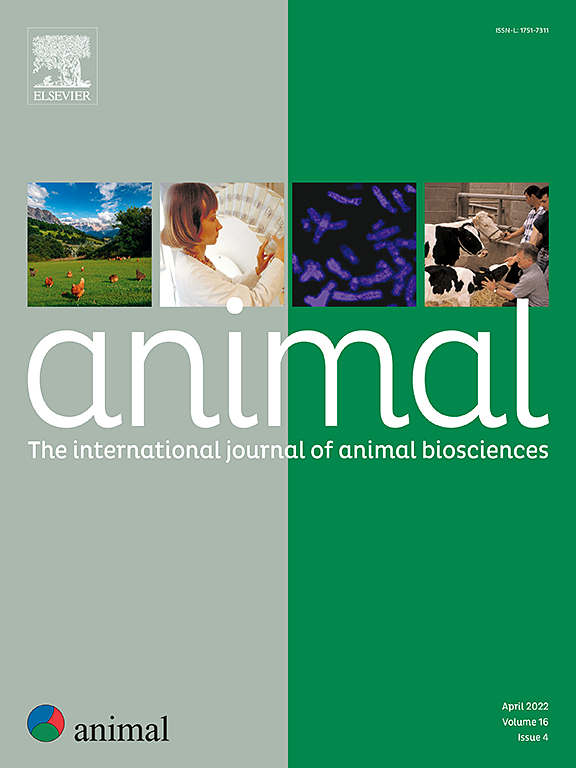死亡、安乐死、屠杀还是活着?1023头艾尔郡和荷尔斯坦奶牛的结果以及兽医治疗与死亡率之间的关系
IF 4
2区 农林科学
Q1 AGRICULTURE, DAIRY & ANIMAL SCIENCE
引用次数: 0
摘要
动物福利和疾病预防是现代乳制品行业追求可持续性和责任的重要考虑因素。疾病对奶牛的福利、寿命、产奶量和终身生产力产生负面影响,并通过这些影响农场经济和生产供人类消费的乳制品所需的资源。无人协助的死亡和安乐死是指奶牛因疾病或创伤而过早离开牛群,没有经过深思熟虑的计划。我们研究的目的是描述奶牛退出畜群的不同方式和农民报告的扑杀原因,并比较无辅助死亡或在农场实施安乐死的奶牛的特征和兽医治疗史。我们研究了芬兰国家奶牛群体改善数据库中的数据,并对芬兰76个畜群中的10023头奶牛进行了305天的跟踪调查。根据农民报告的奶牛离开牛群的方式,我们根据奶牛在随访期结束时的状态将其分为四类:无辅助死亡(die),在农场安乐死(EUT),被送去屠宰,或留在牛群中活着,分别占研究人群的2%,4%,17%和77%。我们分析了奶牛的特征和奶牛接受的兽医治疗(VET),并使用广义线性混合模型探讨了它们与农场死亡的关系。总体而言,艾尔郡奶牛和荷斯坦奶牛(HOL)的存活率相似,但HOL奶牛在农场死亡的频率更高。死亡奶牛产犊至产犊的中位时间为26 d, EUT奶牛为38 d。与EUT奶牛相比,接受过兽医治疗的死亡奶牛比例较小,但疾病范围更广。有产犊困难和消化道疾病的兽医增加了奶牛死亡的几率,与没有兽医记录相比,有牛奶热、消化道或爪子和腿部疾病的兽医增加了成为EUT奶牛的几率。为了获得更多有助于降低未来死亡率的知识,我们建议(1)在即将进行的淘汰和死亡率研究中,将死亡奶牛和未死亡奶牛分开;(2)在乳制品行业中,将奶牛退出牛群的方式纳入常规监测和报告统计,并将更详细的牛群具体分析纳入农民和顾问的工具中,以便在单个牛群水平上进行基准测试和解决问题。本文章由计算机程序翻译,如有差异,请以英文原文为准。
Died, euthanised, slaughtered or alive? outcomes for 10 023 Ayrshire and Holstein cows and associations between veterinary treatments and mortality
Animal welfare and disease prevention are important considerations for the modern dairy industry that strives for sustainability and responsibility. Diseases negatively impact cow welfare, lifespan, milk yield and lifetime productivity, and through those, farm economy, and resources needed in producing dairy foods for human consumption. Unassisted deaths and euthanasia represent cows that have suffered from an illness or trauma and leave the herd too early and without deliberate planning. The objectives of our study were to describe different ways cows exit the herd and farmer-reported reasons for culling, and to compare characteristics and veterinary treatment history of cows that either died unassisted or were euthanised on-farm. We studied data from the Finnish national Dairy Herd Improvement database and followed 10 023 cows in 76 herds in Finland, for 305 days. Based on a farmer-reported way for a cow exiting the herd, we grouped the cows into four categories based on their status at the end of the follow-up period: died unassisted (DIED), were euthanised (EUT) on farm, were sent to slaughter, or stayed alive in a herd, which accounted for 2, 4, 17, and 77% of the study population, respectively. We analysed cow characteristics and veterinary treatments (VET) the cows had received and explored their associations with on-farm deaths using generalised linear mixed models. Overall, the survival of Ayrshire and Holstein (HOL) cows was similar, but HOL cows died on farm more often. The median time from calving to exit was 26 days for DIED and 38 days for EUT cows. Compared to EUT cows, a smaller proportion of DIED cows had been treated by a veterinarian, but for a wider range of diseases. Having a VET for calving difficulty and digestive tract disease increased the odds of being a DIED cow, and VETs for milk fever, digestive tract or claw and leg diseases increased the odds of being an EUT cow, compared to not having the VET recorded. To gain more knowledge which could help to reduce mortality in the future, we suggest (1) separating the groups of DIED and EUT cows in forthcoming studies on culling and mortality, and (2) including the way dairy cows exit a herd into routinely monitored and reported statistics within the dairy industry and more detailed herd specific analyses into farmers’ and advisors’ tools for benchmarking and problem−solving at individual herd level.
求助全文
通过发布文献求助,成功后即可免费获取论文全文。
去求助
来源期刊

Animal
农林科学-奶制品与动物科学
CiteScore
7.50
自引率
2.80%
发文量
246
审稿时长
3 months
期刊介绍:
Editorial board
animal attracts the best research in animal biology and animal systems from across the spectrum of the agricultural, biomedical, and environmental sciences. It is the central element in an exciting collaboration between the British Society of Animal Science (BSAS), Institut National de la Recherche Agronomique (INRA) and the European Federation of Animal Science (EAAP) and represents a merging of three scientific journals: Animal Science; Animal Research; Reproduction, Nutrition, Development. animal publishes original cutting-edge research, ''hot'' topics and horizon-scanning reviews on animal-related aspects of the life sciences at the molecular, cellular, organ, whole animal and production system levels. The main subject areas include: breeding and genetics; nutrition; physiology and functional biology of systems; behaviour, health and welfare; farming systems, environmental impact and climate change; product quality, human health and well-being. Animal models and papers dealing with the integration of research between these topics and their impact on the environment and people are particularly welcome.
 求助内容:
求助内容: 应助结果提醒方式:
应助结果提醒方式:


